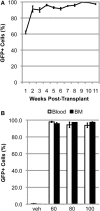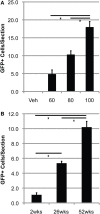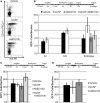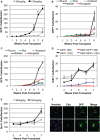Bone Marrow-Derived Cell Accumulation in the Spinal Cord Is Independent of Peripheral Mobilization in a Mouse Model of Amyotrophic Lateral Sclerosis
- PMID: 28337172
- PMCID: PMC5340765
- DOI: 10.3389/fneur.2017.00075
Bone Marrow-Derived Cell Accumulation in the Spinal Cord Is Independent of Peripheral Mobilization in a Mouse Model of Amyotrophic Lateral Sclerosis
Abstract
Bone marrow-derived cells (BMDCs) are capable of migrating across the blood-brain barrier (BBB) and accumulating in the central nervous system (CNS) when transplanted into recipients conditioned with whole-body irradiation or chemotherapy. We used the chemotherapeutic agents busulfan and treosulfan to condition recipient mice for transplantation with bone marrow (BM) cells isolated from donor mice ubiquitously expressing green fluorescent protein. We attempted to increase the accumulation of BMDCs in the CNS by mobilization of BMDCs using either, or both, granulocyte colony-stimulating factor (GCSF) or plerixafor (AMD3100). We also used several concentrations of busulfan. We hypothesized that higher concentrations of busulfan and BMDC mobilization would increase numbers of GFP+ cells in the CNS. The doses of busulfan employed (60-125 mg/kg) all resulted in high levels of sustained chimerism (>85% 1 year post-transplant) in both the blood and BM of wild-type (WT) mice and an amyotrophic lateral sclerosis (ALS) mouse model. Moreover, cells accumulated within the CNS in a dose-, time-, and disease-dependent manner. Conditioning with the hydrophilic busulfan analog treosulfan, which is unable to cross the BBB efficiently, also resulted in a high degree of BM chimerism. However, few GFP+ BMDCs were found within the CNS of WT or ALS mice of treosulfan-conditioned mice. Mobilization of BMDCs into the circulation using GCSF and/or AMD3100 did not lead to increased accumulation of GFP+ BMDCs within the CNS of WT or ALS mice. Weekly analysis of BMDC accumulation revealed that BMDCs accumulated more rapidly and to a greater extent in the CNS of ALS mice conditioned with a high dose (125 mg/kg) of busulfan compared to a lower dose (80 mg/kg). The number of GFP+ BMDCs in the CNS labeling with the proliferation marker Ki67 increased in parallel with BMDC accumulation within the CNS. Our results indicate that establishment of high levels of blood and BM chimerism alone is not sufficient to induce BMDC accumulation within the CNS and that CNS conditioning is a crucial requirement for BMDC accumulation to occur. Moreover, it appears that proliferation of BMDCs that infiltrate the CNS is partly responsible for cell accumulation in busulfan-conditioned ALS mice.
Keywords: AMD3100; amyotrophic lateral sclerosis; bone marrow-derived cells; busulfan; central nervous system; granulocyte colony-stimulating factor; monocyte; treosulfan.
Figures






Similar articles
-
Neuroimmune Crosstalk Between the Peripheral and the Central Immune System in Amyotrophic Lateral Sclerosis.Front Aging Neurosci. 2022 May 3;14:890958. doi: 10.3389/fnagi.2022.890958. eCollection 2022. Front Aging Neurosci. 2022. PMID: 35592701 Free PMC article. Review.
-
Submyeloablative conditioning with busulfan permits bone marrow-derived cell accumulation in a murine model of Alzheimer's disease.Neurosci Lett. 2015 Feb 19;588:196-201. doi: 10.1016/j.neulet.2015.01.023. Epub 2015 Jan 9. Neurosci Lett. 2015. PMID: 25582787
-
Busulfan as a myelosuppressive agent for generating stable high-level bone marrow chimerism in mice.J Vis Exp. 2015 Apr 1;(98):e52553. doi: 10.3791/52553. J Vis Exp. 2015. PMID: 25867947 Free PMC article.
-
Myelosuppressive conditioning using busulfan enables bone marrow cell accumulation in the spinal cord of a mouse model of amyotrophic lateral sclerosis.PLoS One. 2013 Apr 8;8(4):e60661. doi: 10.1371/journal.pone.0060661. Print 2013. PLoS One. 2013. PMID: 23593276 Free PMC article.
-
Treosulfan-based conditioning for inborn errors of immunity.Ther Adv Hematol. 2021 May 20;12:20406207211013985. doi: 10.1177/20406207211013985. eCollection 2021. Ther Adv Hematol. 2021. PMID: 34094045 Free PMC article. Review.
Cited by
-
Modifying macrophages at the periphery has the capacity to change microglial reactivity and to extend ALS survival.Nat Neurosci. 2020 Nov;23(11):1339-1351. doi: 10.1038/s41593-020-00718-z. Epub 2020 Oct 19. Nat Neurosci. 2020. PMID: 33077946
-
Neuroimmune Crosstalk Between the Peripheral and the Central Immune System in Amyotrophic Lateral Sclerosis.Front Aging Neurosci. 2022 May 3;14:890958. doi: 10.3389/fnagi.2022.890958. eCollection 2022. Front Aging Neurosci. 2022. PMID: 35592701 Free PMC article. Review.
-
Bone marrow-derived myeloid cells transiently colonize the brain during postnatal development and interact with glutamatergic synapses.iScience. 2024 May 21;27(7):110037. doi: 10.1016/j.isci.2024.110037. eCollection 2024 Jul 19. iScience. 2024. PMID: 39021809 Free PMC article.
-
Inhibition of glycolytic reprogramming suppresses innate immune-mediated inflammation in experimental amyotrophic lateral sclerosis.Inflamm Res. 2024 Nov;73(11):1847-1857. doi: 10.1007/s00011-024-01935-z. Epub 2024 Aug 21. Inflamm Res. 2024. PMID: 39167140
-
Hematopoietic stem cell transplantation chemotherapy causes microglia senescence and peripheral macrophage engraftment in the brain.Nat Med. 2022 Mar;28(3):517-527. doi: 10.1038/s41591-022-01691-9. Epub 2022 Feb 21. Nat Med. 2022. PMID: 35190726
References
LinkOut - more resources
Full Text Sources
Other Literature Sources
Molecular Biology Databases
Miscellaneous

